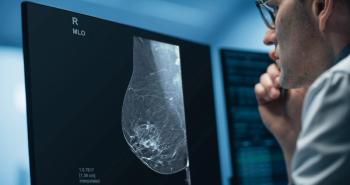
DBT Yields Lower Recall Rates, But Not for Every Radiologist
Research reveals half of radiologists saw no change in their recall rates.
Recall rates for digital breast tomosynthesis (DBT) are lower than with digital mammography (DM), and its cancer detection rates are higher, but new research reveals not every radiologist has achieved the recommended recall rate threshold.
According to a large, multi-institutional, U.S.-based study, published on March 30 in
“Our results demonstrate a clinically important downward shift in the distribution of radiologist recall rates with DBT screening among a large, geographically diverse sample of U.S. radiologists,” wrote lead study author Brian L. Sprague, Ph.D., with the University of Vermont Cancer Center.
In 2013, the American College of Radiology established a recommended mammography recall rate of no more than 12 percent. But, existing research indicates many radiologists – approximately two-thirds – still fall below this threshold. To evaluate provider performance, Sprague’s team assessed recall and cancer detection rates for radiologists both before and after they began interpreting DBT exams.
Overall, they found radiologists who mainly used DBT had recall rates that fell in line with the ACR recommendation. They were also less likely to have exams recalled for re-evaluation, the team said.
For their analysis, the team gathered data from six Breast Cancer Surveillance Consortium registries that included U.S. providers from a number of different practice settings. Alongside looking at recall and cancer detection rates for providers who used both DBT and DM, they also considered the performance of radiologists who only read DM results in order to adjust for other trends.
Based on their analysis, mammography recall rates fell to 8.8 percent after adding DBT from 10 percent before its use. In addition, more radiologists were able to achieve the 12 percent recall rate threshold – increasing from 66 percent before use to 76 percent after. Most significantly, DBT recall rates stayed lower than those with DM even after the authors adjusted for any confounding variables. The DBT recall rate was 15 percent lower after adjustment, according to the authors.
DBT also improved cancer detection rates, the authors said. Radiologists who began using DBT found the cancer detection rate rose to 5.3 per 1,000 exams after implementation from 4.7 per 1,000 exams before use.
Despite the better recall and cancer detection rates with DBT, however, the authors determined not all radiologists experience the same improvements. According to their analysis, exactly half of providers saw no difference in their recall rates after adding DBT, and approximately 14 percent saw an increase in patient recalls. Although the team found no pattern between radiologist specialty, fellowship training, or practice characteristics, they did determine that providers who used DBT more than 50 percent of the time were more likely to have a reduced recall rate.
To further understand this trend and any individual factors that could impact the findings, additional research is needed, the team asserted. But, steps can be taken now to help providers improve their recall and detection rates.
“Radiology practices should audit radiologist DBT performance statistics closely and consider additional DBT training for radiologists whose screening performance does not improve as expected,” Sprague wrote. “Policymakers and women should be informed that most women undergoing DBT examinations will experience a reduced recall rate and elevated cancer detection rate, although these benefits will vary substantially depending on the individual radiologist interpreting the examination.”
Newsletter
Stay at the forefront of radiology with the Diagnostic Imaging newsletter, delivering the latest news, clinical insights, and imaging advancements for today’s radiologists.




























